
18 minute read
Culture to go
Old villages, big mountains: the Walser Kulturweg – the Walser Culture Trail – runs through the entire Kleinwalsertal valley
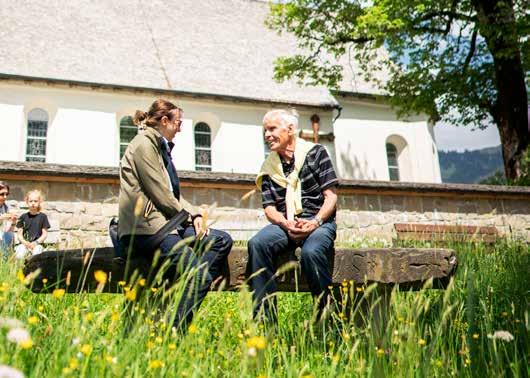
Meeting: Wolfgang Hilbrand with author Kornelia Dietrich Remembering: panels explain sights worth seeing – including the Walserhaus (Walser House)
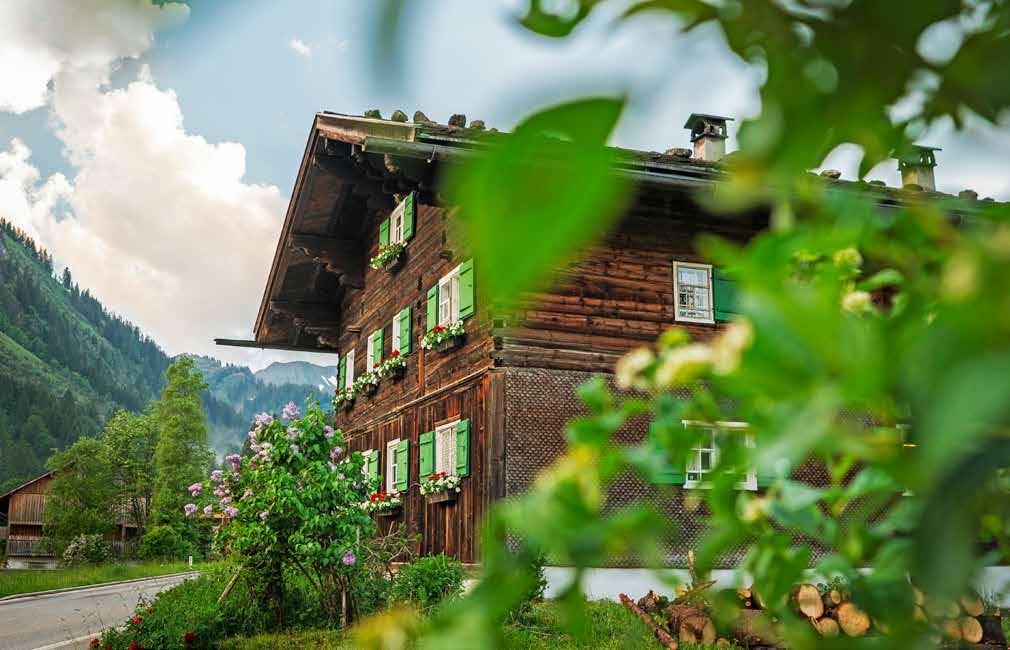
We meet Wolfgang Hilbrand sitting on a bench at Mittelberg’s church. It can’t be missed as the starting point for our hike: its 66-metre-high spire is the village’s and – for many – even the entire Kleinwalsertal valley’s landmark. “It’s more than 600 years old and has never had to be
restored,” says Wolfgang Hilbrand proudly. Five Walser families arrived here from Switzerland and settled here at the end of the 13th century. “They didn’t have any steel or iron so they built walls that are between two and a half and three metres thick in order to ensure that St. Joduk would last forever.”

The Walser have left their mark in many places between Riezlern and Baad. And so, a few years ago, Wolfgang Hilbrand came up with the idea of creating the Culture Trail, a hiking trail that takes visitors through beautiful scenery through the valley and at the same time explains many of the things that some people would otherwise pass by without noticing. The ‘Uusrüafschtei’, for example, which is a flat stone slab behind the church. “It weighs several tonnes and was dragged here on a sleigh in 1595 – there wasn’t any other way of transporting objects that were that heavy.” The Waibel, the usher, would stand on it every week after Sunday service and read the news: which meadows were to be sold or when the next cattle auction would be taking place. “That was the easiest way to reach the whole community since at the time everyone went to mass.” The church these days is often quite empty when Reverend Edwin Matt, whom Mittelberg shares with the neighbouring parishes, climbs the pulpit every second Sunday. But, on this sunny afternoon, we meet many visitors who have come to see the frescoes, the beautiful altar and the painted wooden Vortragetafel (Carrier Panel) that the girls used to carry in front of them in processions, hence the name. “Are you from here?” A man asks whose accent clearly reveals that he’s from the Ruhr district. He then immediately follows that up with: “When does the Corpus Christi procession start tomorrow?”
What Heinzen are? Wooden hangers above the doors which used to be used for drying hay
We walk past the sacristan’s house, old Walser stables, the ‘Hoflaada’ (‘Farm Shop’), where the wooden Heinzen, which used to be used to hang small bundles of grass to dry in bad weather, are still to be seen above the doors. This is the place where tradition and modern technology meet – inside this building customers are able to draw fresh organic farm milk

Walser Kulturweg (Cultural Trail)
The Culture Trail runs through the entire Kleinwalsertal valley. An interactive digital map also provides information about the routes. The Mittelberger Runde (Mittelberg Round Trip) is eight kilometres long. Hikers wishing to take their time at the 20 stations without hurrying should plan a good three hours for the tour. There are similar round trips in Hirschegg (11 stations, 2.5 kilometres), Riezlern (10 stations, 13 kilometres) and a round trip around the valley (9 stations, 20 kilometres). And it’s always possible to hop on the Walserbus, which connects all the villages, to shorten the trip. The bus is free of charge for holders of the Kleinwalsertal Guest Card. Tour details: www.vorarlberg.travel/walser-cultural-trail


from the milk-vending machine – automatically, cooled and hygienically. Mountain cheese and yoghurt are also available from vending machines and we quickly get chatting with visitors from Bavaria who’ve come to us to change banknotes into coins so that they can pack the delicacies into their hiking rucksacks.
Wolfgang Hilbrand knows all the stories – even the gruesome ones
We knock on the door of the more than 450-year-old Kohler Walserhaus in Bödmen and are allowed in to admire the parlour with its wood panelling and ‘Herrgottswinkel’ (shrine) that has hardly changed for generations. We meet lots of hikers coming the other way who give us a friendly greeting as they pass. And local residents keep stopping Wolfgang to have a chat with him – everyone in Mittelberg seems to know him – no wonder, he was headmaster at the elementary school until he retired. And that’s why he also knows the gruesome stories that are associated with the 15th century conciliation crosses that we pass on our way. These are memorial crosses that murderers were
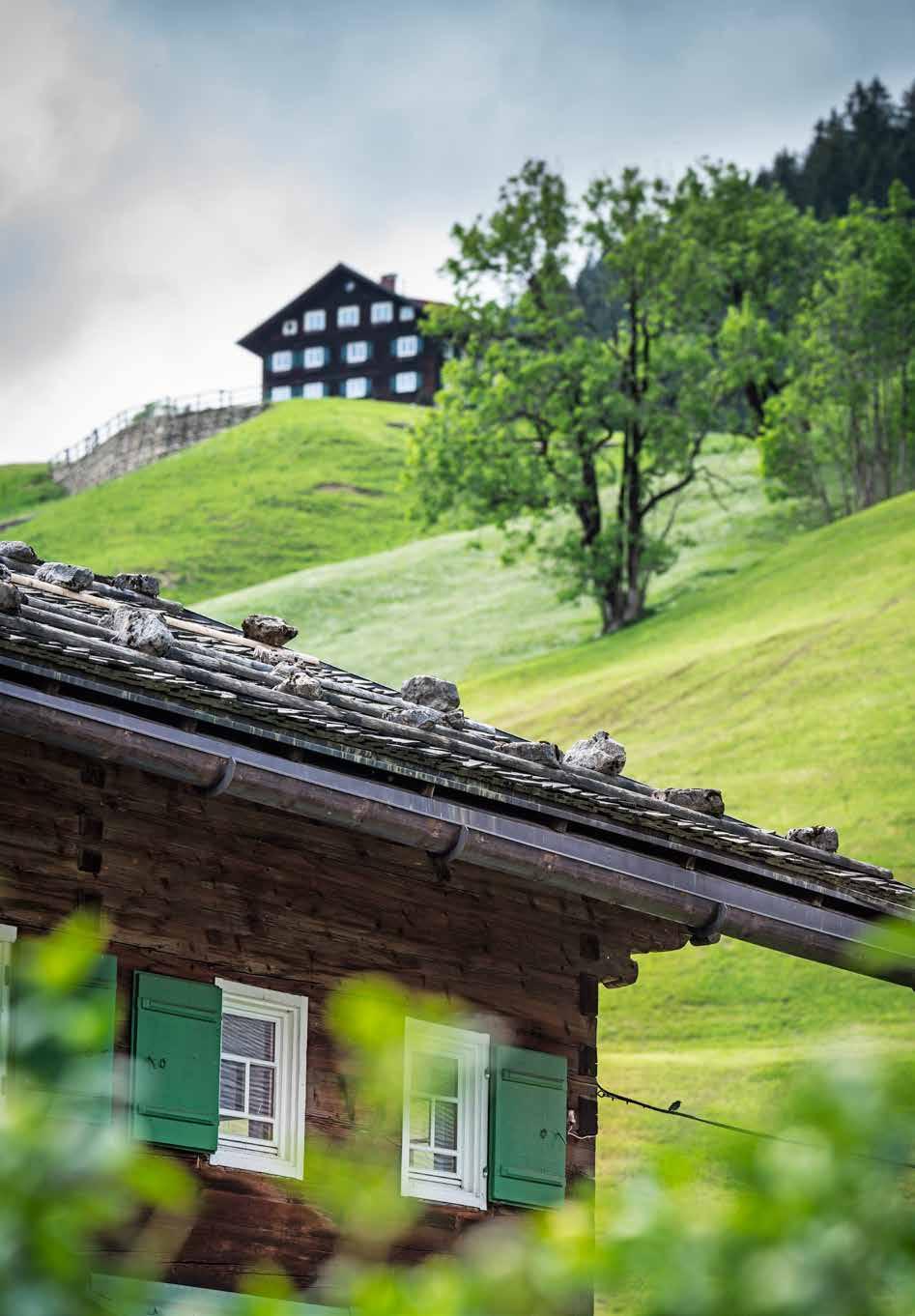
Organic dairy products: also available from the vending machine. Changing bank notes for coins is a good way of meeting people
Mountain water: well on the Baad-Mittelberg high trail
forced to carve out of stone with their own hands and that were then installed at the scenes of their crimes: a man who got into an argument with his three brothers after a drinking session and killed them all or a father who killed his son.

Interested visitors, however, may also walk the Culture Trail without a guide because there’s a small guide to the sights, too, that’s available from the tourist office. And plaques have been installed at each monument that tell the associated stories; the texts were written by Wolfgang Hilbrand – so expertise and love of the homeland are guaranteed. We walk past the alpine woods, through colourful meadows full of dandelions, clover, crowfoots and buttercups. Bees buzz and swallows circle high above us until the trail gently descends to the chapel of St. Martin in Baad. Our guide thinks it’s a little gem – and not only because of the beautifully painted ceiling. “I’m particularly fond of this church because we celebrated our golden wedding anniversary here,” he says.
Baad is the last stop. Not only for our little trip – this is also where the Kleinwalsertal valley ends, the small village is surrounded by mountains, the only road leads back to Mittelberg. “We’re the most beautiful cul-de-sac in Austria,” says Wolfgang. “And we want it to stay that way – we’ve always resisted a through road.” Which they have fortunately done with success.
More information about the Walser Culture Trail and holidays in the Kleinwalsertal valley is available at: www.kleinwalsertal.com
Culture that brings people together
Picking up particular nuances, get talking about design and discovering art outside in the fresh air – this is where we present interesting sources of inspiration for the curious
1
Music is taken to the mountains Unusual places and top-notch musicians from a variety of genres make the charming duo that is the annual ‘Montafoner Resonanzen’ music festival. That’s where people come together in summer to play jazz and jam in the lofty mountains. Other areas of focus include wind instruments, folk music, cross-over and chamber music. The programme also includes events with organ music every year. www.vorarlberg.travel/montafon-resonances
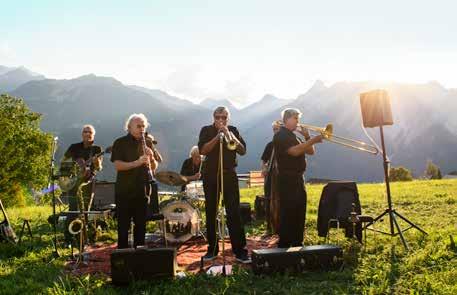

2
When the artists and the audience… This innovative festival is all about give and take. The programme, which is dedicated to a specific theme three times a year, aims to encourage local and international artists as well as performers and guests to engage in vibrant exchanges. The topics here include central socio-political questions and moods. The Montforter Zwischentöne events take place at a variety of venues in Feldkirch. The topics they take up are linked to the respective season as well as regional customs and festivals. www.montforter-zwischentoene.at
3 4
Literature at unusual places This new cultural festival is all about poetry, battling, whispering, drawing and sometimes even making music. The Kleinwalsertal Literature Festival aims to bring together texts, poets and unusual places in the Vorarlberg valley. Interactions, for example, between walking and listening to texts or between the artists and the audience are also explored here. The three-day event along with a specific motto is taken to the mountains every two years and definitely crosses genres. www.kleinwalsertal.com
‘Beauty’ at the vorarlberg museum Why do people feel drawn to beauty? What are the positive effects that beauty can have? The ‘Beauty’ exhibition at the vorarlberg museum in Bregenz deals with these and similar questions. It was conceived by Stefan Sagmeister, a graphic artist from Vorarlberg who now lives in New York, and graphic artist Jessica Walsh, who hails from the USA. The objects originated in different worlds – graphics, product design, architecture and urban planning. And they reveal that beauty is not only beautiful but also functional. From June 2020 to January 2021. www.vorarlbergmuseum.at
5

Making music together A cross-national orchestra with young musicians from the Lake Constance region – that was the idea behind the ‘Quarta 4 Länder Jugendphilharmonie’ (‘Quarta 4 Country Youth Philharmonics’) project. A place of encounter where friendships for life are formed. The young talents rehearse together under the supervision of initiator and conductor Christoph Eberle. Their concerts may then be enjoyed during spring and autumn at several locations in Vorarlberg – from Bregenz to Bludenz. www.vorarlberg.travel/ music-across-borders

6
Next stop: art! Open-air art that is freely accessible and invites you to reflect, enjoy and stay: there’s a whole range of interesting ‘art stops’ in Vorarlberg. Pieces that fascinate are, for example, the bronze sculpture “Homage to Brigantium” by Herbert Albrecht on the waterfront promenade in Bregenz and the light tunnel by Gerry Ammann at the harbour. Today’s artists not only want to enhance the look of the site with their works but also open them up and create connections, for instance, between art and the buildings or in interaction with nature. So just stop for a moment and let the effect of art works soak in. A selection of pieces may be found here: www.vorarlberg.travel//art-in-public-spaces
7
Being inspired by the new Trade fairs are meeting places to marvel at: several special events in Vorarlberg attract attention. They stand for a close relationship between products and designers and invite people to inform themselves, appreciate and buy. Inquiries expressly desired! It’s often even possible to watch manufacturing processes. Interesting, beautiful, sustainable things, many from local manufacturers and designers, are to be found, for example, at the ‘Unikat B’, an exhibition for applied art and design in Bludenz. The ‘POTENTIALe’ trade fair in Feldkirch is also unusual in that it’s simultaneously a festival where the aim is to enable visitors to experience what a future worth living could look like. www.vorarlberg.travel/discover-design
Pushing the boundaries in a good way: writer Stefan Herbke and son Moritz made the panoramic trip together
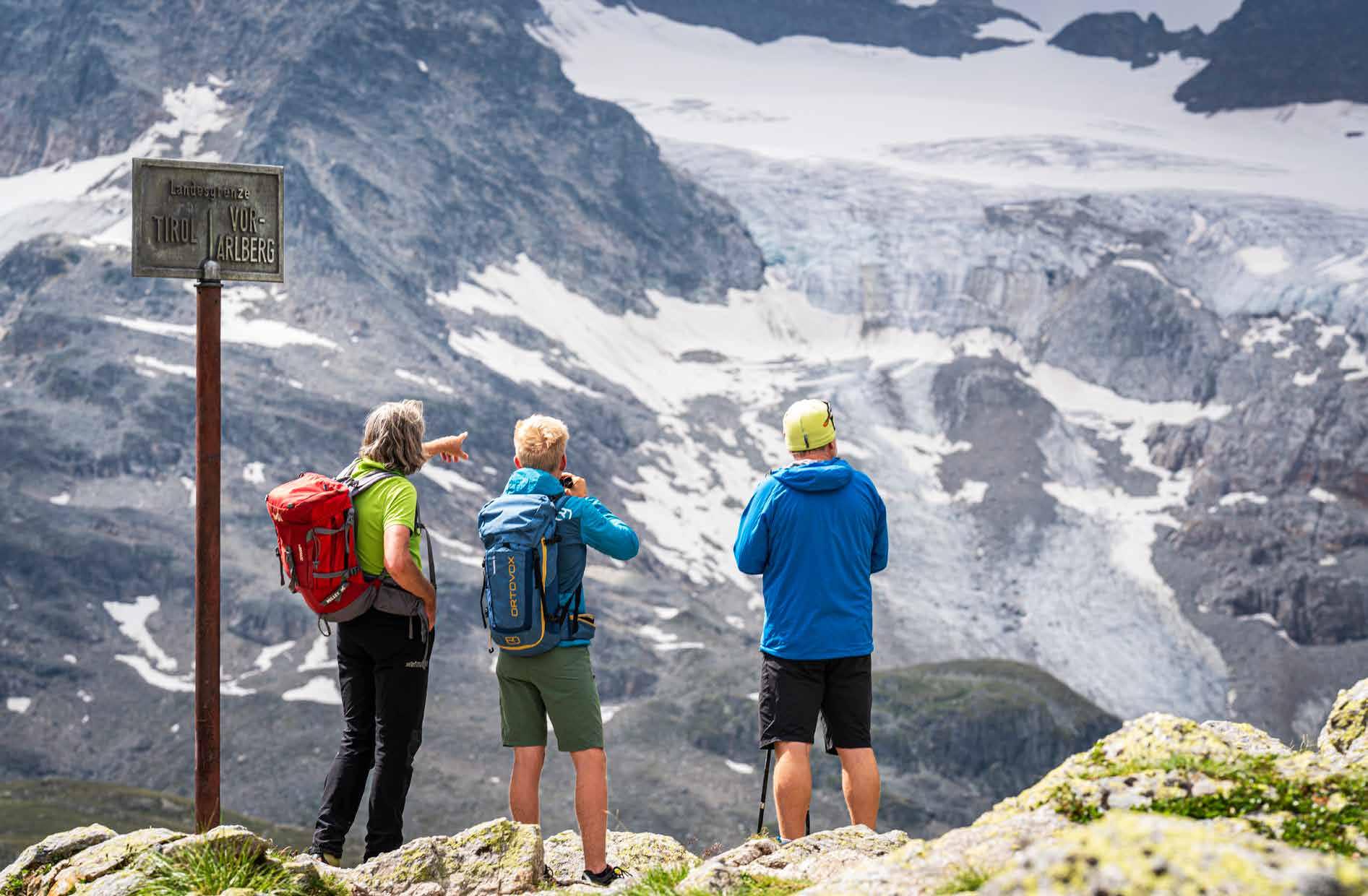
Mountain yearning
Many people see hiking on the trails in the Silvretta mountains in the Montafon region as a way to unwind from their everyday lives. The high alpine panoramic trail around the Hohe Rad rewards hikers with impressive views of Piz Buin, which is the highest mountain in Vorarlberg. But there’s even more to discover here: green meadows, glaciers and sometimes even your partner for life

TEXT: STEFAN HERBKE PHOTOS: DIETMAR DENGER
And off we go: across alpine meadows and past grazing cows to the Radsattel mountain
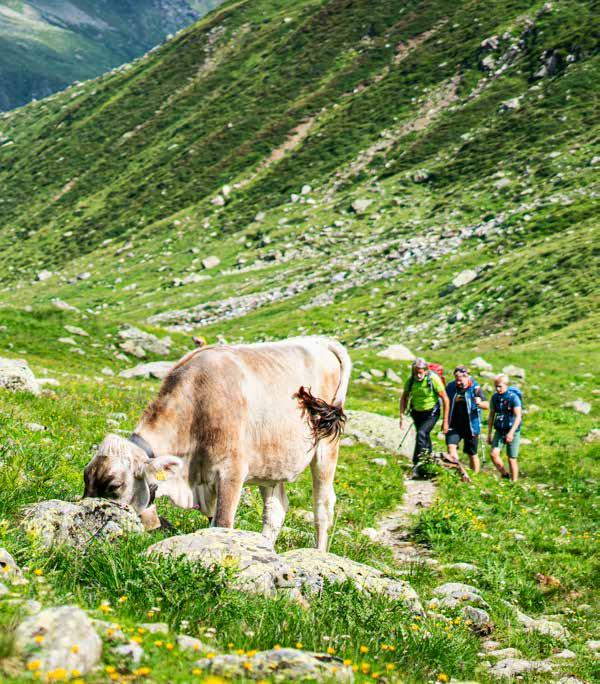
Arrived: Tina Reyer, who runs the alpine hut, is glad to have got her first season under her belt
»I am not a classic alpine host, I feel more comfortable in rock and ice. «
Tina Reyer, landlady at the Wiesbadener Hütte
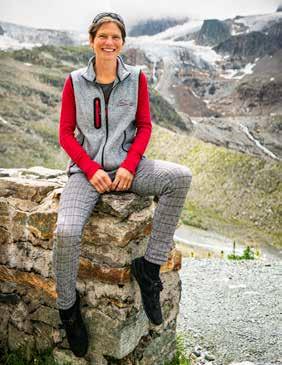
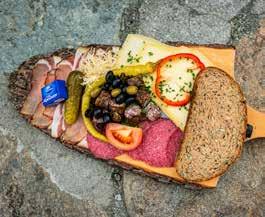
Well-deserved break: a hearty snack awaits you at the Wiesbadener Hütte
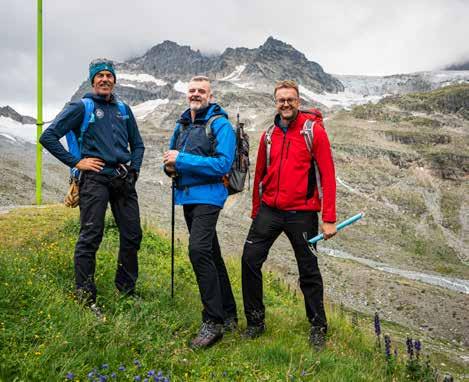


Thunderous finale: this impressive waterfall awaits on the descent through the Ochsental valley


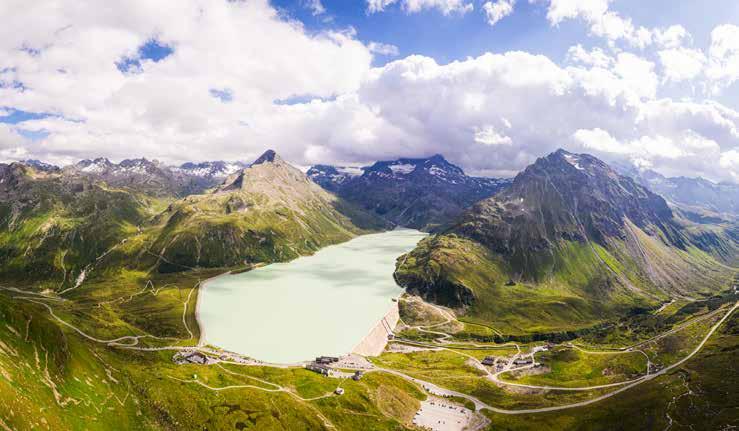
Embedded: the Silvrettasee lake with the Hohe Rad and Piz Buin mountains Onlooker: an ibex watches the hikers from up close
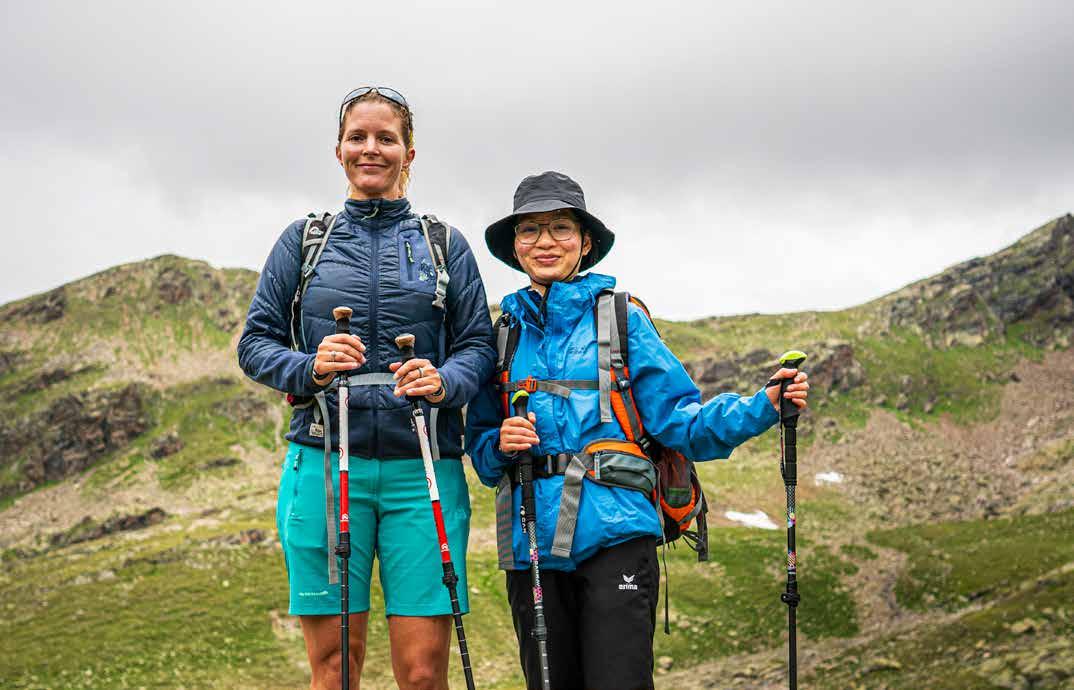
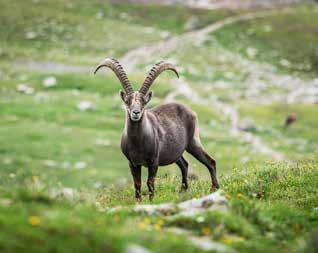
Whatever your worries are, you’ll forget about them at the latest when you reach the summit,” says Klaus Kühlechner. The 65-year-old has realised his dream of living in the mountains and working as a hiking guide. And he continues to look forward to every single day that he can spend high up in the Silvretta mountains: “You just stop thinking and simply enjoy the panorama – it touches your heart.” Slowly, almost thoughtfully, Klaus sets off from the Bielerhöhe and proceeds with steady steps towards the Bieltal valley, past the Silvretta reservoir with its ice-cold waters, while the Silvretta range’s three thousand-metre-tall mountains in the background look like they’re wearing fluffy hats because they’re all poking their high peaks into the clouds. “I want to show visitors my home,” Klaus explains, “then they’ll understand why I live here and never want to leave.” The view from the top of the Radsattel opens up to the heart of the Silvretta mountains The best proof of this is the hike that Klaus is taking us on today: the panoramic trip around the Hohe Rad mountain. The hike starts at the Bielerhöhe and continues into the Bieltal valley and then across the Radsattel to the Wiesbadener Hütte at the foot of Piz Buin – at 3,312 metres, the highest peak in Vorarlberg. The fascinating round trip starts at the lake and leads hikers across green alpine meadows almost up to the glaciers. The vegetation becomes sparser with every metre climbed, trained eyes will recognise old moraines, deposits of debris and boulders, that are clear indicators of the glaciers’ former dimensions. The ice has, however, long since retreated, water gushes everywhere, cows graze beside the path. The first steep ledge already results in an encounter with the first hikers coming from the Wiesbadener Hütte. Some seem to be in a hurry and want to get back to the valley as quickly as they can. Others, like Petra Dimitrovova from the Czech Republic and Huyen Vuong from Vietnam, are more inclined towards taking their time, entirely in line with the motto: “The path is the destination.” The two young women work in Switzerland, live in Vorarlberg and are thrilled with the mountains. “There are, of course, mountains in Vietnam,” says Huyen, “but hiking is not at all popular there.” But she can find many like-minded people here. “We sit in the office all week,” says Petra, “so we need to do something to unwind at the weekend – and that’s what the mountains help us do. And you’re always meeting nice people.” And then the two set off again towards the valley albeit a bit hesitantly: “We’re a bit wary of the cows.”

We sit in the office all week and it helps us unwind when we’re in the mountains. «
Petra Dimitrovova

Panoramic trip around the Hohe Rad
The round trip, which boasts lots of variety, takes hikers from the Bielerhöhe (2,036 m) across the Silvretta reservoir’s dam into the Bieltal valley. The rather leisurely start is followed by a somewhat steeper but short ascent past the Radsee lake to the Radscharte (2,652 m). The descent, which presents views of Piz Buin and the Ochsentaler Glacier and is interrupted by a short counter-ascent, takes hikers to the Wiesbadener Hütte (2,443 m) and then on to a narrow track back to the Silvretta reservoir and the Bielerhöhe. Hiking time: 6 to 6.30 hours Getting there: it’s possible to drive on the Silvretta-Hochalpenstraße (toll road) to the starting point or comfortably take the bus. A guided hike is offered once a week during the summer. The Montafon Guest Card entitles users to a 20% discount; there’s no charge for guests of the BergePLUS partner businesses.
Information and dates at: www.montafon.at
Fit and thrilled with the mountains: Petra Dimitrovova from the Czech Republic and Huyen Vuong from Vietnam live in Vorarlberg

The view from the top of the Radsattel presents the heart of the Silvretta range and the still impressive Ochsentaler Glacier with its crevasses and tongues of ice. Fascinating, even for Jonas Hermann, who can’t take his eyes off the vista. He was born in Franconia in Germany and even as a child he couldn’t wait for his annual trip to see his grandparents in Pinzgau during the holidays. “I feel safe in the mountains,” says Jonas, “and I really missed them at my last job in Frankfurt,
especially the peace and quiet and the endless nature.” He now lives and works in Tirol and it’s really easy for him to get to the mountains by public transport. “I like to go a little faster when I’m out, also because of the benefits that hiking brings as an exercise,” he says, “but I then occasionally like to stop for a little longer, take a seat and just look.”
We almost didn’t see the ibex for looking; it was standing just a few metres beside the path and was staring at us with curiosity. “Many of our guests find
Happy to reach the summit: the Swijnenburg family from the Netherlands. Parents Maud and Harry met in the mountains
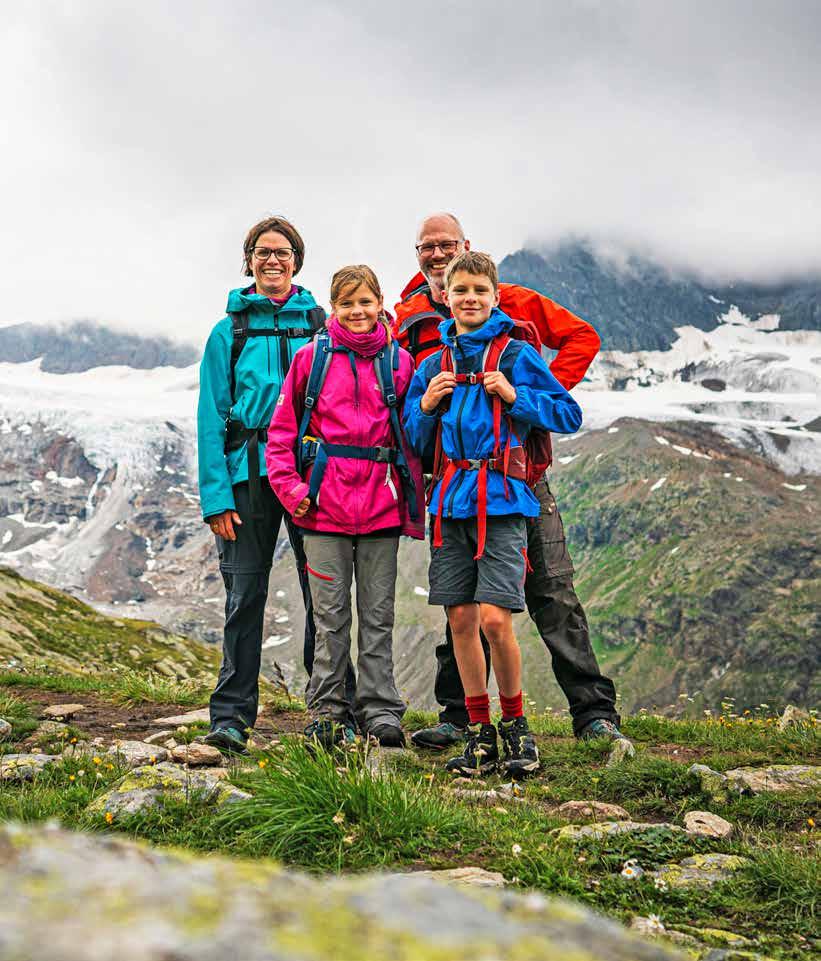
Sure-footed: it’s sometimes a steep climb up the Radsattel Hiking guide: Klaus Kühlechner offers tips for the tour
it almost incredible when they see such an impressive animal in nature.” Klaus is happy about the surprising encounter and adds: “Such experiences make the effort of making the long climb worthwhile.” The ibex would certainly have thrilled the Swijnenburg family’s two children but they’re even more excited about the large snow field they’ve discovered directly next to the trail. “We love the mountains, particularly because of the
views,” raves Harry Swijnenburg about his holidays in the Alps. “We obviously don’t have any at home in the Netherlands.” He met his now wife Maud on a training course at an Alpine Club hut 22 years ago: “We now have two children and still enjoy hiking in the mountains.” The kids also like going to the sea, of course, but Harry says: “We’ve usually had enough of the water after two days.” The children are not quite as enthusiastic even if snowball fights in summer provide a welcome change and twelve-year-old Kelvin raves about the glaciers. Maud reveals how she motivates the children: “We’ve promised them that they can have Kaiserschmarrn when we stop for a break at the alpine hut.”
The dream of the summit demands a lot but it also gives a lot back
Day trippers, hikers and mountaineers sit comfortably together on the Wiesbadener Hütte’s terrace while landlords Emil Widmann and Tina Reyer and their team tirelessly serve drinks and food. The weekends are very busy for them and the hut’s 180-bed capacity is completely booked out. Tina is proud of their successful first season and the location in sight of the glaciers: “I simply feel more at home in rock and ice – I am not a classic alpine host.” But she hasn’t yet had time to climb Piz Buin. For others like Jochen Krauss and Thomas Ogermann from Germany, on the other hand, a dream has come true, they’ve just come from Piz Buin, the most famous peak in the Silvretta range of mountains. “That was a very special experience,” says a thrilled Jochen. “We had fog and sleet showers but the sun did come out for a short time at the summit.“ And hiking with crampons was especially exciting as it was a first for both of them. “It’s only natural that you sometimes push yourself to your limits in the mountains and sometimes you even have to go beyond them,” says Jochen, “but, in regard to Piz Buin, it was clear from the outset that we’d only go with a mountain guide.” A task that Andreas Pecl from the Vorarlberger Lawinenwarndienst (Vorarlberg Avalanche Warning Service) is happy to assume. He accompanied the two and is pleased with how the day went: “They handled themselves well.” Andreas has probably been up Piz Buin around one hundred times and he, too, looks forward to every tour in the mountains that are his home. “I’ve had many wonderful moments here even if they were often only brief – but those are precisely the times that make living here special.”

Hiking in the Montafon region A total of 21 three-thousand-metre peaks and 1,160 kilometres of marked hiking trails await visitors. There’s something for everyone here – from family walks to trips to the summit.
More information:
www.montafon.at/hiking; www.silvretta-bielerhoehe.at
Good advice: Raphael Mäser of Hotel Alpenrose with his grandmother, the founder Fini Mäser




